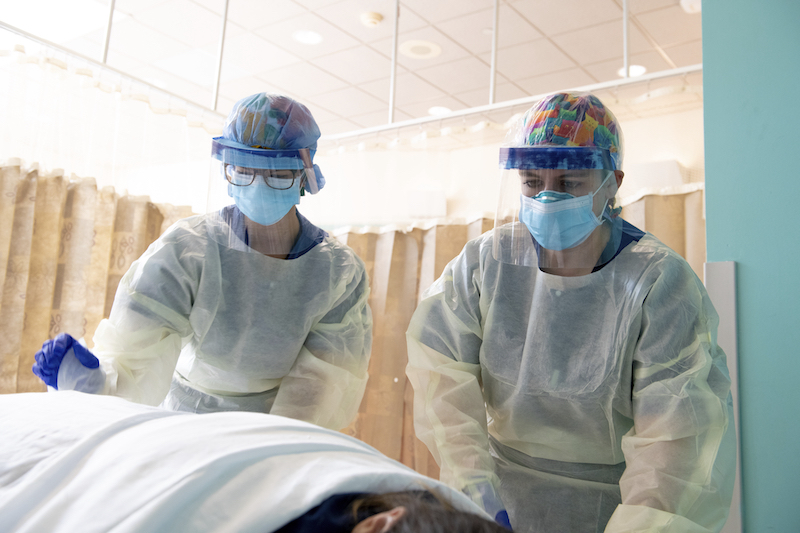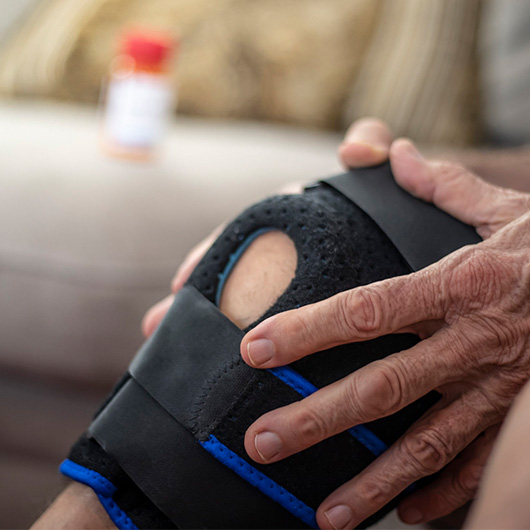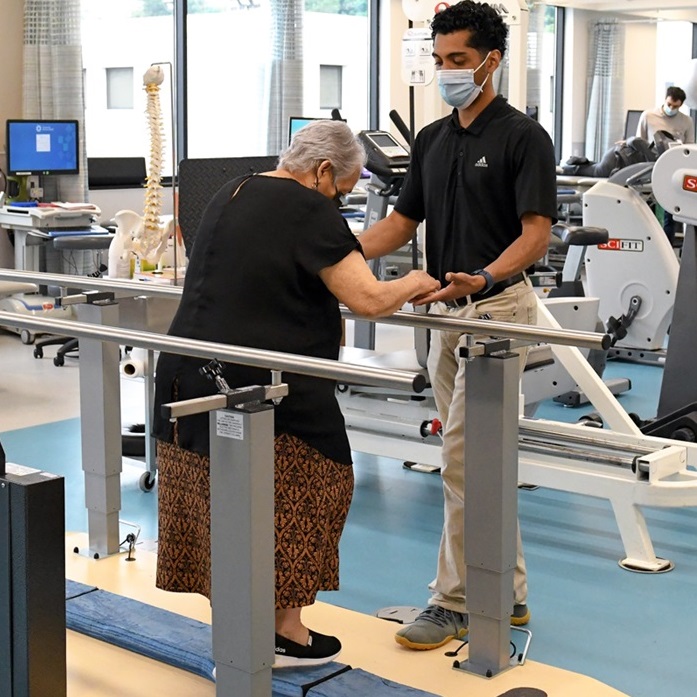What is Proning and How May it Help COVID-19 Patients?

May 06, 2020
By Brianna McCabe
“Close your eyes and imagine a synchronized swimming team,” shares Nancy Vassallo, interim clinical educator of Critical Care at JFK Medical Center.
Do you think about the tactful calculations of each movement per split second by the swimmers, which creates a beautiful dance performance within a pool?
“The same goes for proning,” adds Nancy, “except the health of our patients is the goal. It’s a slow, controlled and perfectly timed team movement.”
What is proning?
According to Nancy, proning is the process of turning a patient with precise, safe motions from their back onto their abdomen (stomach) so the individual is lying face down. The expert notes that it is especially beneficial in comprised COVID-19 patients with or without ventilator needs and says, “The position allows for better expansion of the dorsal (back) lung regions, improved body movement and enhanced removal of secretions which may ultimately lead to advances in oxygenation (breathing).”
How does it help with COVID-19 patients?
As detailed by Lenore Reilly, nurse manager of Critical Care at JFK Medical Center, some patients experiencing mild respiratory distress who do not need a ventilator, or those who could progress to severe respiratory distress, show improved oxygenation from proning.
“There is not enough evidence at this time to prove that proning alleviates patients needing ventilators,” Lenore says. “What we can see, though, is that oxygenation is temporarily improved. This is why proning has become part of the plan of care during the COVID-19 pandemic.”
How many people does it take to prone a patient?
At JFK Medical Center, a proning team typically consists of six highly trained experts including:
- Registered nurses (with either critical care or operating room expertise)
- Respiratory therapists
- Physical therapists/occupational therapists/patient care technicians
- Anesthesia physicians
“This number can increase based on the individual needs of the patient,” says Lenore.
As described by both Nancy and Lenore, a registered nurse will lead the proning team at the head of the patient bed and provide clear directions regarding the step-by-step process. The lead registered nurse, along with an additional registered nurse or a respiratory therapist, will guide the patient’s head and airway. Joining them are two physical therapists (or other support staff) on each side of the patient to help manage movement of the arms, legs, intravenous (IV) access and other catheters (tubes).
What are the steps in the proning process?
“The patient will go through a series of manual turns that are done in a synchronized pattern,” says Lenore. The team leader will coordinate with the other team members in each of the motions that are necessary to get the patient to a prone position. “Anesthesia physicians are also available for airway (breathing) management,” she continues.
The patients will be moved laterally (sideways) followed by turning the patient on their side and finally onto their abdomen. Each position requires the patient’s heart rate, blood pressure and pulse oximetry (oxygenation level) to remain stable during each move. “The process takes time, patience and skill to make sure that the patient remains stable,” elaborates Nancy.
How often and how long is a patient proned?
Patients are placed in the prone position for 16 to 18 hours and then placed in the supine position (lying horizontally with the face and torso facing up) for 6 to 8 hours if the oxygen levels are able to tolerate it. “While the patient is either in the prone and/or supine position, specific lab and radiology studies will be ordered,” says Lenore. “The findings of these particular procedures will drive if the patient will continue with prone positioning daily.”
Can all patients benefit from proning?
All patients that may benefit from proning are evaluated by a critical care physician and/or pulmonologist to determine if a patient is a “good candidate” for proning, Lenore notes. However, a patient may be unqualified for proning if they have:
- Spinal instability
- Unstable fractures
- Open wounds
- Burns
- Tracheal surgery
- A baby in utero (over 24+ weeks pregnant)
“There may be additional complications that we have to look out for on a case-by-case basis, such as cardiac (heart) abnormalities or prior abdominal surgery, to determine if proning would be beneficial,” explains Nancy.
If a patient does qualify, though, he/she will undergo a thorough preparation stage, explains Nancy. “This process would include making sure that the eyes and skin will be protected during the time that they are prone,” she says. “In addition, the patients will need proper sedation and IV access.”
Are there risks to proning?
As stated by Lenore, some risks associated with proning include:
- Airway obstruction
- Dislodgement of endotracheal tube
- Pressure-related skin injuries
- Facial and airway edema (swelling)
- Hypotension (low blood pressure)
- Arrhythmias (irregular heartbeat/rate)
“The synchronized movements are done very slowly and methodically so the entire proning team can safely monitor the patient to prevent the associated risks,” assures Nancy.
Next Steps and Resources:
- To make an appointment with a doctor near you, call 800-822-8905 or visit our website.
- Learn more about COVID-19.
The material provided through HealthU is intended to be used as general information only and should not replace the advice of your physician. Always consult your physician for individual care.

Do Over-the-Counter Knee Braces Help?
Knee pain from injuries or arthritis isn’t one-size-fits-all.

Can COVID-19 Cause Back Pain?
Rehabilitation specialists share how COVID-19 and back pain may be related, and tips on how to prevent and treat back pain.

4 Common Injuries from Combat Sports
Craig Van Dien, M.D., says that he frequently sees hand and wrist injuries related to combat sports.


